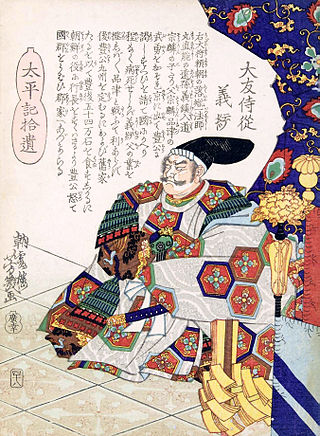
Shimazu Yoshihisa was a powerful daimyō and the 16th Chief of Shimazu clan of Satsuma Province, the eldest son of Shimazu Takahisa. He was renowned as a great general, who managed to subjugate Kyushu through the deft maneuvering of his three brothers. Eventually, in 1585, Yoshihisa seceded control of the entire Kyushu region.

Shimazu Yoshihiro was the second son of Shimazu Takahisa and the younger brother of Shimazu Yoshihisa. Traditionally believed to be the 17th head of the Shimazu clan, he was a skilled general during the Sengoku period who greatly contributed to the unification of Kyūshū.

Ōtomo clan was a Japanese samurai family whose power stretched from the Kamakura period through the Sengoku period, spanning over 400 years. The clan's hereditary lands lay in Kyūshū.

Ōtomo Sōrin, also known as Fujiwara no Yoshishige or Ōtomo Yoshishige, was a Japanese feudal lord (daimyō) of the Ōtomo clan, one of the few to have converted to Catholicism. The eldest son of Ōtomo Yoshiaki, he inherited the Funai Domain, on Kyūshū, Japan's southernmost main island, from his father. He is perhaps most significant for having appealed to Toyotomi Hideyoshi to intervene in Kyūshū against the Shimazu clan, thus spurring Hideyoshi's Kyūshū Campaign of 1587.

The Kyūshū campaign of 1586–1587 was part of the campaigns of Toyotomi Hideyoshi who sought to dominate Japan at the end of the Sengoku period. Having subjugated much of Honshū and Shikoku, Hideyoshi turned his attention to the southernmost of the main Japanese islands, Kyūshū.

Kobayakawa Takakage was a samurai and daimyō during the Sengoku period and Azuchi–Momoyama period. He was the third son of Mōri Motonari who was adopted by the Kobayakawa clan and became its 14th clan head. He merged the two branches of the Kobayakawa, the Takehara-Kobayakawa clan (竹原小早川氏) and Numata-Kobayakawa clan (沼田小早川氏). He became an active commander of the Mōri army and he with his brother Kikkawa Motoharu became known as the “Mōri Ryōsen", or “Mōri's Two Rivers" (毛利両川). As head of the Kobayakawa clan, he expanded the clan's territory in the Chūgoku region, and fought for the Mōri clan in all their campaigns
The Battle of Mimigawa was fought in Japan between the Ōtomo clan and the Shimazu clan in 1578. The Ōtomo force was led by Sorin's brother-in-law Tawara Chikataka, while the Shimazu clan was led by Shimazu Yoshihisa.
The 1587 Battle of Takajō, also known as the Battle of Takashiro, was the first battle in Toyotomi Hideyoshi's campaigns to seize control of Kyūshū during Japan's Sengoku period.

Tachibana Ginchiyo was head of the Japanese Tachibana clan and onna-musha during the Sengoku period. She was a daughter of Tachibana Dōsetsu, a powerful retainer of the Ōtomo clan. Because Dosetsu had no sons, he requested that Ginchiyo be made family head.

Kitsuki Domain was a feudal domain under the Tokugawa shogunate of Edo period Japan, in what is now northern Ōita Prefecture. It was centered around Kitsuki Castle in what is now the city of Kitsuki and was ruled by the fudai daimyō Nomi-Matsudaira clan for most of its history.

Funai Domain was a feudal domain under the Tokugawa shogunate of Edo period Japan, in what is now southern Ōita Prefecture. It was centered around Funai Castle in what is now the city of Ōita and was ruled by the fudai daimyō Ogyū-Matsudaira clan for most of its history.
Shimazu Toyohisa or Shimazu Tadatoyo, son of Shimazu Iehisa and nephew of Shimazu Yoshihiro, was a Japanese samurai who was a member of the Shimazu clan. He was also the castle lord in command of Sadowara Castle. He served in the Battle of Kyushu (1587) under his uncle against the Toyotomi. He fought bravely, but was ambushed off route when he charged forward. He was saved by his uncle. His wife was the daughter of Shimazu Tadanaga, cousin and karō to Shimazu Yoshihisa.

Oka Castle was a Sengoku to Edo period yamajiro-style Japanese castle located in the city of Taketa, Ōita Prefecture, Japan. Its ruins have been protected as a National Historic Site since 2023.
Miyohime (美代姫) or Enkyū Myōgetsu (圓久妙月) was a Japanese Onna-musha from the late-Sengoku period. She was a retainer of Ryūzōji clan. After her husband and Ryūzōji Takanobu were slain in the Battle of Okitanawate, she became the head of 'Kamafunatsu castle' and 'Hyakutake clan'.

Saiki Castle was an Edo period yamajiro-style Japanese castle located in the city of Saiki, Ōita Prefecture, Japan. Its ruins have been protected as a National Historic Site since 2023. It is No.194 on the list "Continued 100 Fine Castles of Japan".
Oni Gozen (鬼御前) was a Japanese noble lady and onna-musha from the Sengoku period. She was the wife of Hoashi Akinao (帆足鑑直) the retainer of Ōtomo clan. She was a military commander who actively participated in the Kyushu campaign of 1586–1587, helping to repel the Shimazu army from the Ōtomo clan.
Shigashi (志賀氏) (-d.1587) was a Japanese noble lady and Japanese warrior from the Sengoku period. Shigashi means the lady from Shiga clan and her real name is unknown. She was the wife of Bekki Shigetsura (戸次鎮連) the retainer of Ōtomo clan, the nephew and the son-in-law of famed samurai Bekki Akitsura a.k.a. Tachibana Dōsetsu. She is best known for her role during conflicts between the Shimazu clan and the Ōtomo clan in Kyushu.

Ōtomo Yoshimune was a Japanese daimyō of the Sengoku period, heir of Otomo Sōrin at the head of the Ōtomo clan. He was the eldest son and successor of Otomo Sōrin as lord of the Bungo Province. His mother was an anti-Christian, known today only for the Jesuit epithet for her, Jezebel. His wife was Yoshihiro Kikuhime.

Usuki Domain was a feudal domain under the Tokugawa shogunate of Edo period Japan, in what is now eastern Ōita Prefecture. It was centered around Usuki Castle in what is now the city of Usuki, Ōita and was ruled by the tozama daimyō Inaba clan for all of its history.













